The Risk of Protectionism: What Can Be Lost?
Abstract
1. Introduction
2. A Brief History of Globalization: The First and Second Wave
- (i)
- Less developed technical infrastructure and higher transportation and communication costs during the first wave (Figure 2). It was essential for financial transactions, where the telegraph was the only means of rapid information transmission for conducting financial transactions and financial market arbitrage at the end of the 19th and early 20th centuries. As a result, the specter of financial market products traded internationally was smaller compared to the contemporary era.
- (ii)
- Less liberal trade regimes during the first wave: import tariffs were, on average, higher before WWI than in the 2000s and 2010s (Estevadeordal 1997). In particular, this was the case in the US, Russia, Argentina, Canada, Portugal, Spain, Norway, and Finland. Tariffs were lower in the United Kingdom, France, and Switzerland and close to zero in the Netherlands. There were also intra-imperial preferential trade regimes (in the British and French empires). On the other hand, non-tariff barriers, such as sanitary, phytosanitary, and technical standards, played a more limited role.
- (iii)
- Geographical coverage: pre-WWI globalization was limited to Western Europe and the US. Most of today’s EMDEs remained in colonial dependence, and they benefited from economic integration only marginally and often in a distorted form.
3. Gains from Globalization 1980–2020
3.1. Global Economic Growth
3.2. Eradicating Poverty
3.3. Diminishing Global Income Inequalities
3.4. Disinflation
3.5. Globalization-Related Challenges and Socio-Political Costs
4. Protectionist Backlash and Associated Risks to Global Socio-Economic Development
4.1. Change in Integration Trend
4.2. The Rise of China and the US–China Trade Conflict
4.3. A New Protectionist Rhetoric
4.4. Geopolitical Tensions and Economic Openness
4.5. What Can Be Lost?
5. Remedies
6. Summary and Conclusions
Funding
Data Availability Statement
Conflicts of Interest
| 1 | For the purpose of this essay, we use Wolf’s (2005, p. 14) definition of economic globalization as ‘the integration of economic activity across borders, through markets’. For a broader discussion of this notion, see, e.g., https://www.piie.com/microsites/globalization/what-is-globalization (accessed on 18 August 2024). |
| 2 | Patel et al.’s (2024) analysis, which presents the growth convergenge benefits of hyperglobalization and warns of potential global losses, is one of exceptions. |
| 3 | Sachs (2020) distinguishes seven ages of globalization, starting from the Paleolithic Age and ending with the contemporary Digital Age. His periodization is based on technical innovation and refers not only to economic integration. This essay focuses on the role of policies and regulatory regimes in economic integration (although does not abstract from technical and technological factors) and concentrates on the last 150 years. |
| 4 | |
| 5 | The Spanish–US war in 1898 and the Japanese–Russian war in 1904–1905 were exceptions. However, these were relatively short episodes of limited scale. In addition, Japan, Russia, and Spain played peripheral roles in the world economy at that time. |
| 6 | The Smoot–Hawley Tariff Act adopted by the US Congress in June 1930 increased US import tariffs to a record-high level and triggered a global trade war because other countries retaliated (see Mitchener et al. 2022). |
| 7 | See https://www.wto.org/english/thewto_e/whatis_e/tif_e/fact4_e.htm (accessed on 18 August 2024). |
| 8 | The data for EMDEs are available from 1997 only. |
| 9 | PTAs have both trade creation and trade diversion effects. If the latter is stronger than former, the net effect is negative. However, even if the net effect is positive, PTAs are the second-best solution when compared to global trade liberalization. Bhagwati (2008) calls them ‘termites in the trading system’. |
| 10 | See https://tron.trade.ec.europa.eu/investigations/ongoing (accessed on 14 June 2024). |
| 11 | See https://ec.europa.eu/commission/presscorner/detail/en/ip_24_3231 (accessed on 18 August 2024). |
| 12 | See, e.g., https://webapi2016.eesc.europa.eu/v1/documents/eesc-2013-06859-00-00-ac-tra-en.doc/content (accessed on 18 August 2024). |
| 13 | This essay does not have the ambition to offer a comprehensive assessment of policy responses to the COVID-19 pandemic and speculate whether there were other, better responses. The focus is only on the impact of adopted policies on protectionist sentiments and specific arguments used in the policy debate. |
| 14 | The 1990s were not free from violent conflicts, for example, in the former Yugoslavia and many corners of Africa. However, they were isolated, involved countries with negligible shares of global output, and did not negatively impact international economic cooperation and governance. |
| 15 | In 2022, China accounted for 18.4% of the world GDP in PPP terms, while Russia accounted for 2.9%. China’s share of the world exports of goods and services amounted to 11.9%, and Russia’s share amounted to 1.8% (IMF 2023, Table A, p. 99). |
| 16 | Hufbauer et al. (2022) argued that a trade liberalization package amounting to 2 percentage points of a tariff-equivalent reduction (mainly reversal of the import tariff increases of the Trump administration) could offer a one-off reduction of US inflation by ca. 1.3 percentage points. |
| 17 | The US’ objections were articulated, among others, by the US Trade Representative (2020). |
| 18 | See https://www.wto.org/english/thewto_e/minist_e/mc12_e/briefing_notes_e/bfwtoreform_e.htm (accessed on 18 August 2024). |
| 19 | See https://www.dfat.gov.au/trade/agreements/in-force/rcep (accessed on 18 August 2024). |
| 20 | Among EMDEs, India and Kazakhstan account for the largest budgetary support to agriculture calculated in % of gross farm receipts (IMF et al. 2022). |
References
- Allison, Graham. 2023. China’s Dominance of Solar Poses Difficult Choices for the West. Financial Times, June 22. Available online: https://www.ft.com/content/fd8e7175-9423-4042-a6f7-c404afdfcda4 (accessed on 18 August 2024).
- Arndt, Channing, Xinshen Diao, Paul Dorosh, Kaul Pauw, and James Thurlow. 2023. The Ukraine war and rising commodity prices: Implications for developing countries. Global Food Security 36: 100680. [Google Scholar] [CrossRef] [PubMed]
- Astrov, Vasily, Carsten Brockhaus, Julian Hinz, Levke Jessen-Thiesen, Hendrik Mahlkow, and Patrik Svab. 2024. Navigating Trade Restrictions. WIIW Russia Monitor, February, No. 3. Available online: https://wiiw.ac.at/navigating-trade-restrictions-dlp-6810.pdf (accessed on 18 August 2024).
- Bhagwati, Jagdish. 2004. In Defense of Globalization. New York: Oxford University Press. [Google Scholar]
- Bhagwati, Jagdish. 2008. Termites in the Trading System: How Preferential Agreements Undermine Free Trade. New Delhi: Oxford University Press. [Google Scholar]
- Bhagwati, Jagdish. 2012. The Broken Legs of Global Trade. WTO Public Forum 2012, Research and Analysis, June 5. Available online: https://www.wto.org/english/forums_e/public_forum12_e/art_pf12_e/art10.htm (accessed on 20 August 2024).
- Bickenbach, Frank, Dirk Dohse, Rolf J. Langhammer, and Wan-Hsin Liu. 2024. Foul Play? On the Scale and Scope of Industrial Subsidies in China. Kiel Policy Brief, No. 173, April, Kiel Institute for the World Economy. Available online: https://www.ifw-kiel.de/fileadmin/Dateiverwaltung/IfW-Publications/fis-import/bc6aff38-abfc-424a-b631-6d789e992cf9-KPB173_en.pdf (accessed on 20 August 2024).
- Bilousova, Olena, Benjamin Hilgenstock, Elina Ribakova, Nataliia Shapoval, Anna Vlasyuk, and Vladyslav Vlasiuk. 2024. Challenges of Export Controls Enforcement: How Russia Continues to Import Components for Its Military Production. Yermak-McFaul International Working Group on Russian Sanctions & Kyiv School of Economics Institute, January. Available online: https://sanctions.kse.ua/wp-content/uploads/2024/01/Challenges-of-Export-Controls-Enforcement.pdf (accessed on 18 August 2024).
- Bordo, Michael D., Barry Eichengreen, and Douglas A. Irwin. 1999. Is Globalization Today Really Different than Globalization a Hunderd Years Ago? NBER Working Paper, No. 7195. June. Available online: https://www.nber.org/system/files/working_papers/w7195/w7195.pdf (accessed on 18 August 2024).
- Bown, Chad P. 2023a. Modern industrial policy and the WTO. PIIE Working Papers 23–15, December. Available online: https://www.piie.com/sites/default/files/2023-12/wp23-15.pdf (accessed on 18 August 2024).
- Bown, Chad P. 2023b. US-China Trade War Tariffs: An Up-to-Date Chart. In PIIE Charts. Washington, DC: Peterson Institute for International Economics, April 6, Available online: https://www.piie.com/research/piie-charts/2019/us-china-trade-war-tariffs-date-chart (accessed on 18 August 2024).
- Bown, Chad P., and Melina Kolb. 2023. Trump’s Trade War Timeline: An Up-to-Date Guide. In Trade and Investment Policy Watch. Washington, DC: Peterson Institute for International Economics, December 31, Available online: https://www.piie.com/blogs/trade-and-investment-policy-watch/2018/trumps-trade-war-timeline-date-guide (accessed on 18 August 2024).
- Cerdeiro, Diego, Siddharth Kothari, and Dirk Muir. 2023. Harm From ‘De-Risking’ Strategies Would Reverberate Beyond China. IMF Blog, October 17. Available online: https://www.imf.org/en/Blogs/Articles/2023/10/17/harm-from-de-risking-strategies-would-reverberate-beyond-china (accessed on 18 August 2024).
- Chinn, Menzie D., and Hiro Ito. 2006. What Matters for Financial Development? Capital Controls, Institutions, and Interactions. Journal of Development Economics 81: 163–92. Available online: http://web.pdx.edu/~ito/w11370.pdf (accessed on 18 August 2024).
- Choyleva, Diana. 2024. Xi’s Prioritization of Security Will Continue to Weigh on Growth. In China 2024: What to Watch? New York and Washington, DC: Asia Society Policy Institute’s Center for China Analysis, January. Available online: https://asiasociety.org/sites/default/files/2024-01/China2024_webreport_fin.pdf (accessed on 18 August 2024).
- Chupilkin, Maxim, Beata Javorcik, Aleksandra Peeva, and Alexander Plekhanov. 2024. Decision to Leave: Economic Sanctions and Intermediated Trade. Paper presented at the 20th EUROFRAME Conference on Economic Policy Issues in the European Union, Kiel, Germany, June 7. Available online: https://www.euroframe.org/files/user_upload/euroframe/docs/2024/Conference/Session%20C1/EUROF24_Chupilkin_etal.pdf (accessed on 18 August 2024).
- Dabrowski, Marek. 2021. Thinking Beyond the Pandemic: Monetary Policy Challenges in the Medium- to Long-Term. Paper presented at the European Parliament’s Committee on Economic and Monetary Affairs (Monetary Dialogue March 2021), Brussels, Belgium, March 4. PE 658.221. Available online: http://www.europarl.europa.eu/cmsdata/230556/CASE_formatted.pdf (accessed on 18 August 2024).
- Dabrowski, Marek. 2023. A Limping Transition: The Former SOVIET Union Thirty Years On. Bruegel Essay, No. 01/2023. Available online: https://www.bruegel.org/sites/default/files/2023-02/Transition%20in%20the%20FSU_essay%20140223%20HB.pdf (accessed on 18 August 2024).
- Dabrowski, Marek, and Svetlana Avdasheva. 2023. Sanctions and Forces Driving to Autarky. In The Contemporary Russian Economy: A Comprehensive Analysis. Edited by Marek Dabrowski. Cham: Palgrave Macmillan, pp. 271–88. [Google Scholar] [CrossRef]
- Dadush, Uri. 2023. American Protectionism. Revue d’économie Politique 133: 497–524. [Google Scholar] [CrossRef]
- Dadush, Uri. 2024. Rippling Out: Biden’s Tariffs on Chinese Electric Vehicles and Their Impact on Europe. Bruegel Analysis, May 16. Available online: https://www.bruegel.org/sites/default/files/2024-06/rippling-out%3A-biden%E2%80%99s-tariffs-on-chinese-electric-vehicles-and-their-impact-on-europe-9985.pdf (accessed on 18 August 2024).
- Dadush, Uri, and Andre Sapir. 2021. Is the European Union’s Investment Agreement with China Underrated? Bruegel Policy Contribution, April 13. Issue 09/2021. Available online: https://www.bruegel.org/sites/default/files/wp_attachments/PC-09-2021_.pdf (accessed on 18 August 2024).
- Dadush, Uri, and Michael Baltensperger. 2019. The European Union-Mercosur Free Trade Agreement: Prospects and risks. Bruegel Policy Contribution, September 24. No. 2019-11. Available online: https://www.bruegel.org/sites/default/files/wp_attachments/PC-11_2019.pdf (accessed on 18 August 2024).
- Darvas, Zsolt. 2018. Global Income Inequality is Declining—Largely Thanks to China and India. Bruegel Blog. April 19. Available online: https://www.bruegel.org/blog-post/global-income-inequality-declining-largely-thanks-china-and-india (accessed on 18 August 2024).
- Darvas, Zsolt. 2024. Income Inequality Hardly Changed during the COVID-19 Pandemic. Bruegel Analysis. February 8. Available online: https://www.bruegel.org/analysis/income-inequality-hardly-changed-during-covid-19-pandemic (accessed on 18 August 2024).
- Daudin, Guillaume, Matthias Morys, and Kevin H. O’Rourke. 2010. Globalization, 1870–1914. In The Cambridge Economic History of Modern Europe. Edited by Stephen Broadberry and Kevin H. O’Rourke. Cambridge: Cambridge University Press (CUP), pp. 5–29. [Google Scholar] [CrossRef]
- Demarais, Agathe. 2024. The Bigger Picture: The Case for an EU-Mercosur Free Trade Deal. ECFR Commentary, January 15. European Council on Foreign Relations. Available online: https://ecfr.eu/article/the-bigger-picture-the-case-for-an-eu-mercosur-free-trade-deal/ (accessed on 18 August 2024).
- Dizaji, Sajjad F., and Mohammad R. Farzanegan. 2021. Do Sanctions Constrain Military Spending of Iran? Defence and Peace Economics 32: 125–50. [Google Scholar] [CrossRef]
- Echandi, Roberto, Maryla Maliszewska, and Victor Steenbergen. 2022. Making the Most of the African Continental Free Trade Area: Leveraging Trade and Foreign Direct Investment to Boost Growth and Reduce Poverty. Washington, DC: World Bank, June, Available online: https://openknowledge.worldbank.org/bitstreams/91585eee-eab1-5141-b2f0-031af56e860b/download (accessed on 18 August 2024).
- Estevadeordal, Antoni. 1997. Measuring protection in the early twentieth century. European Economic History Review 1: 89–125. [Google Scholar]
- European Commission. 2017. Commission Staff Working Document on Significant Distortions in the Economy of the People’s Republic of China for the Purposes of Trade Defence Investigations. Available online: https://ec.europa.eu/transparency/documents-register/api/files/SWD (accessed on 18 August 2024).
- Evenett, Simon J. 2023. Corporate Subsidies & World Trade: Evidence from the Global Trade Alert Subsidy Inventory 2.0. Presentation to a Joint Webinar Convened by the Italian Society of International Law & Swiss Society of International Law, Global Trade Alert. May 9. Available online: https://gtaupload.s3.eu-west-1.amazonaws.com/Uploads/web/GTA+Subsidy+Inventory+2.0.pdf (accessed on 18 August 2024).
- Fofack, Hyppolyte. 2024. The Future of African Trade in the AfCFTA Era. Brookings Commentary, February 23. Available online: https://www.brookings.edu/articles/the-future-of-african-trade-in-the-afcfta-era/?utm_campaign=Global%20Connection&utm_medium=email&utm_content=295710044&utm_source=hs_email (accessed on 18 August 2024).
- Fouquin, Michel, and Jules Hugot. 2016. Two Centuries of Bilateral Trade and Gravity Data: 1827–2014. CEPII Working Paper, May. No. 2016-14. Available online: https://www.cepii.fr/PDF_PUB/wp/2016/wp2016-14.pdf (accessed on 18 August 2024).
- Fritz, Johannes, and Simon Evenett. 2021. Subsidies and Market Access: New Data and Findings from the Global Trade Alert. VoxEU/Columns, October 25. Available online: https://cepr.org/voxeu/columns/subsidies-and-market-access-new-data-and-findings-global-trade-alert (accessed on 18 August 2024).
- Garten, Jeffrey E. 2021. Three Days at Camp David: How a Secret Meeting in 1971 Transformed the Global Economy. New York: Harper Collins. [Google Scholar]
- Goodhart, Charles, and Manoj Pradhan. 2020. The Great Demographic Reversal: Aging Societies, Waning Inequality and Inflation Revival. Cham: Palgrave Macmillan. [Google Scholar]
- Gopinath, Gita. 2023. Cold War II? Preserving Economic Cooperation Amid Geoeconomic Fragmentation. Plenary Speech by IMF First Managing Deputy Director Gita Gopinath 20th World Congress of the International Economic Association, Colombia. December 11. Available online: https://www.imf.org/en/News/Articles/2023/12/11/sp121123-cold-war-ii-preserving-economic-cooperation-amid-geoeconomic-fragmentation (accessed on 18 August 2024).
- Gordon, Robert J. 2016. The Rise and Fall of American Growth: The U.S. Standard of Living Since the Civil War. Princeton and Oxford: Princeton University Press. [Google Scholar]
- Hilgenstock, Benjamin, Elina Ribakova, and Nataliia Shapoval. 2023. Bold Measures Are Needed as Russia’s Oil Is Slipping Beyond G7 Reach. Special Report. Kyiv School of Economics Institute, November. Available online: https://sanctions.kse.ua/wp-content/uploads/2024/01/OPC_November2023-1.pdf (accessed on 20 August 2024).
- Hufbauer, Gary C., Megan Hogan, and Yilin Wang. 2022. For inflation relief, the United States should look to trade liberalization. Policy Brief No. 22-4, Peterson Institute for International Economics. March. Available online: https://www.piie.com/sites/default/files/documents/pb22-4.pdf (accessed on 18 August 2024).
- Huwart, Jean-Yves, and Loic Verdier. 2013. Economic Globalisation: Origins and consequences. In OECD Insights. Paris: OECD Publishing. [Google Scholar] [CrossRef]
- IMF. 2023. World Economic Outlook: Navigating Global Divergencies. Washington, DC: The International Monetary Fund, October, Available online: https://www.imf.org/-/media/Files/Publications/WEO/2023/October/English/text.ashx (accessed on 18 August 2024).
- IMF, OECD, The World Bank, and World Trade Organization. 2022. Subsidies, Trade, and International Cooperation. Paris: OECD Publishing. [Google Scholar] [CrossRef]
- Ito, Hiro, and Menzie D. Chinn. 2020. Notes on The Chinn-Ito Financial Openness Index 2018 Update. July 12. Available online: https://web.pdx.edu/~ito/Readme_kaopen2018.pdf (accessed on 18 August 2024).
- James, Harold. 2018. Deglobalization: The Rise of Disembedded Unilateralism. Annual Review of Financial Economics 10: 219–37. Available online: https://www.annualreviews.org/doi/pdf/10.1146/annurev-financial-110217-022625 (accessed on 18 August 2024).
- Jean, Sebastien, Ariell Reshef, Gianluca Santoni, and Vincent Vicard. 2023. Dominance on World Markets: The China Conundrum. CEPII Policy Brief, No. 2023-44, CEPII. Available online: https://www.cepii.fr/PDF_PUB/pb/2023/pb2023-44.pdf (accessed on 18 August 2024).
- Kaur, Dashveenjit. 2021. Here’s What the 2021 Global Semiconductor Shortage is All About. Techwire Asia, October 13. Available online: https://techwireasia.com/2021/10/heres-what-the-2021-global-semiconductor-shortage-is-all-about/ (accessed on 18 August 2024).
- Lee, Jong-Wha, and Ju Hyun Pyun. 2009. Does Trade Integration Contribute to Peace? Working Paper Series on Regional Economic Integration, No. 24. Asian Development Bank. January. Available online: https://www.adb.org/sites/default/files/publication/28499/wp24-trade-integration-peace.pdf (accessed on 18 August 2024).
- Leonard, Carol. S. 2023. The Soviet Economy, 1918–1991. In The Contemporary Russian Economy: A Comprehensive Analysis. Edited by Marek Dabrowski. Cham: Palgrave Macmillan, pp. 61–77. [Google Scholar] [CrossRef]
- Leonard, Mark. 2024. Sunset of the Economists. China Books Review, February 1. Available online: https://chinabooksreview.com/2024/02/01/sunset-of-the-economists/ (accessed on 18 August 2024).
- Léry Moffat, Luca, and Niclas Poitiers. 2024. Global Supply Chains: Lessons from a Decade of Disruption. Bruegel Working Paper 05/2024, March 4. Available online: https://www.bruegel.org/sites/default/files/2024-03/WP%2005_0.pdf (accessed on 18 August 2024).
- Maskin, Eric. 2015. Why Haven’t Global Markets Reduced Inequality in Emerging Economies? The World Bank Economic Review 29: S48–52. Available online: https://scholar.harvard.edu/files/maskin/files/world_bank_econ_rev-2015-maskin-s48-52.pdf (accessed on 18 August 2024).
- McWilliams, Ben, Giovanni Sgaravatti, Simone Tagliapietra, and Georg Zachmann. 2024. The European Union-Russia Energy Divorce: State of Play. Bruegel Analysis, February 22. Available online: https://www.bruegel.org/analysis/european-union-russia-energy-divorce-state-play (accessed on 18 August 2024).
- Meltzer, Allan H., and Saranna Robinson. 1989. Stability Under the Gold Standard in Practice. In Money, History, and International Finance: Essays in Honor of Anna J. Schwartz. Edited by Michael. D. Bordo. Chicago and London: The University of Chicago Press. [Google Scholar]
- Milanovic, Branko. 2020. Long-run evolution of global income inequality and its political meaning. Paper presented at the 8th Annual Conference on the Global Economy, Higher School of Economics, Moscow, Russia, November 26. [Google Scholar]
- Mitchener, Kris J., Kevin H. O’Rourke, and Kirsten Wandschneider. 2022. The Smoot-Hawley Trade War. The Economic Journal 132: 2500–33. [Google Scholar] [CrossRef]
- Morys, Matthias, Guillaume Daudin, and Kevin H. O’Rourke. 2008. Globalization 1870–1914. Economics Series Working Papers, No. 395, May, University of Oxford, Department of Economics. Available online: https://ideas.repec.org/p/oxf/wpaper/395.html#download (accessed on 18 August 2024).
- Nellis, Stephen, Karen Freifeld, and Alexandra Alper. 2022. US Aims to Hobble China’s Chip Industry with Sweeping New Export Rules. Reuters, October 10. Available online: https://www.reuters.com/technology/us-aims-hobble-chinas-chip-industry-with-sweeping-new-export-rules-2022-10-07/ (accessed on 18 August 2024).
- O’Rourke, Kevin. H., and Jeffrey G. Williamson. 2000. When Did Globalization Begin? NBER Working Paper, No. 7632, April. Available online: https://www.nber.org/system/files/working_papers/w7632/w7632.pdf (accessed on 18 August 2024).
- Obstfeld, Maurice, and Alan M. Taylor. 2004. Global Capital Markets: Integration, Crisis, and Growth. Cambridge: Cambridge University Press. [Google Scholar]
- Pastor, Lubos, and Pietro Veronesi. 2018. Inequality Aversion, Populism, and the Backlash Against Globalization. NBER Working Paper, No. 24900, August. Available online: https://www.nber.org/system/files/working_papers/w24900/w24900.pdf (accessed on 18 August 2024).
- Patel, Dev, Justin Sandefur, and Arvind Subramanian. 2024. A Requiem for Hyperglobalization: Why the World Will Miss History’s Greatest Economic Miracle. Foreign Affairs, June 12. Available online: https://www.foreignaffairs.com/print/node/1131853 (accessed on 15 August 2024).
- Peksen, Dursun. 2019. When Do Imposed Economic Sanctions Work? A Critical Review of the Sanctions Effectiveness Literature. Defence and Peace Economics 30: 635–47. [Google Scholar] [CrossRef]
- Poitiers, Niclas, and Kamil Sekut. 2024. Knowledge Spillovers and Geopolitical Challenges in Global Supply Chains. Bruegel Working Paper 03/2024, February 29. Available online: https://www.bruegel.org/sites/default/files/2024-02/WP%2003_0.pdf (accessed on 18 August 2024).
- Robinson, Peter, and Niall Ferguson. 2023. Cold War II: Niall Ferguson on the Emerging Conflict with China (Interview). Uncommon Knowledge, May 1, Hoover Institution. Available online: https://www.hoover.org/research/cold-war-ii-niall-ferguson-emerging-conflict-china (accessed on 18 August 2024).
- Rodrik, Dani. 2011. The Globalization Paradox: Democracy and the Future of the World Economy. New York and London: W.W. Norton. [Google Scholar]
- Rogoff, Kenneth. 2003. ‘Globalization and Global Disinflation’, paper prepared for the Federal Reserve Bank of Kansas City conference on ‘Monetary Policy and Uncertainty: Adapting to a Changing Economy’, Jackson Hole, WY, August 29. Available online: https://www.imf.org/en/News/Articles/2015/09/28/04/53/sp082903 (accessed on 15 August 2024).
- Sachs, Jeffrey D. 2020. The Ages of Globalization: Geography, Technology and Institutions. New York: Columbia University Press. [Google Scholar]
- Sapir, Andre. 2023. The Reason for the European Union-Australia Trade Negotiation Hiccup. Bruegel Analysis, November 2. Available online: https://www.bruegel.org/sites/default/files/2023-11/the-reason-for-the-european-union-australia-trade-negotiation-hiccup-9496.pdf (accessed on 18 August 2024).
- Schmucker, Claudia, and Stormy-Annika Mildner. 2023. Reforming the WTO Through Inclusive and Development-friendly Approaches: How to Make Plurilateral Initiatives Work for All. DGAP Policy Brief, No. 26, September 22. Available online: https://dgap.org/system/files/article_pdfs/DGAP%20Policy%20Brief%20No%2026_September%2020_2023_11pp._1.pdf (accessed on 18 August 2024).
- Seong, Jeongmin, Olivia White, Michael Birshan, Lola Woetzel, Camillo Lamanna, Jeffrey Condon, and Tiago Devesa. 2024. Geopolitics and the Geometry of Global Trade. McKinsey Global Institute, January 17. Available online: https://www.mckinsey.com/mgi/our-research/geopolitics-and-the-geometry-of-global-trade (accessed on 18 August 2024).
- Solimano, Andres. 2020. World War I, Hyperinflation in the 1920s, and World War II. In A History of Big Recessions in the Long Twentieth Century. Cambridge: Cambridge University Press, pp. 25–60. [Google Scholar]
- Soobramanien, Teddy, Brendan Vickers, and Hilary Enos-Edu, eds. 2019. WTO Reform: Reshaping Global Trade Governance for 21st Century Challenges. London: Commonwealth Secretariat. Available online: https://www.thecommonwealth-ilibrary.org/index.php/comsec/catalog/download/14/11/77?inline=1 (accessed on 18 August 2024).
- Teodoro, Antonella, and Mike Garratt. 2023. Container Shipping Industry: 2020–2021 Supply and Demand Review. European Commission, Directorate-General for Competition. Available online: https://competition-policy.ec.europa.eu/system/files/2023-10/kd0423946enn_container_shipping_industry_2020-2021_final_report.pdf (accessed on 18 August 2024).
- US Trade Representative. 2020. Report on the Appellate Body of the World Trade Organization. United States Trade Representative, February. Available online: https://ustr.gov/sites/default/files/Report_on_the_Appellate_Body_of_the_World_Trade_Organization.pdf (accessed on 18 August 2024).
- Wache, Benjamin, Stefan Boeters, Merve Mavus Kutuk, Gerdien Meijerink, Maarten Van’t Riet, and Konstantin Sommer. 2024. Decoupling China and Russia from the West: The Effects on Trade. Paper presented at the 20th EUROFRAME Conference on Economic Policy Issues in the European Union, Kiel, Germany, June 7; Available online: https://www.euroframe.org/files/user_upload/euroframe/docs/2024/Conference/Session%20B1/EUROF24_Wache_etal.pdf (accessed on 18 August 2024).
- Webster, Joseph. 2024. China Has Become an Electric Vehicle Export Behemoth. How Should the US and EU Respond? New Atlanticist, February 29. Atlantic Council. Available online: https://www.atlanticcouncil.org/blogs/new-atlanticist/china-has-become-an-electric-vehicle-export-behemoth-how-should-the-us-and-eu-respond/?mkt_tok=NjU5LVdaWC0wNzUAAAGRllFXQwhs4bFh88San8IS8jP6HdfZRcaovHTb6NC4cTHHZFxBB50Q_BUc-zgyT8xTxrGOHfJbg3TXr4OLyVzQC0E-1m4HOHMDwp7N15NGBQHV (accessed on 18 August 2024).
- Wolf, Martin. 2005. Why Globalization Works. Yale Nota Bene, New Haven, and London: Yale University Press. [Google Scholar]


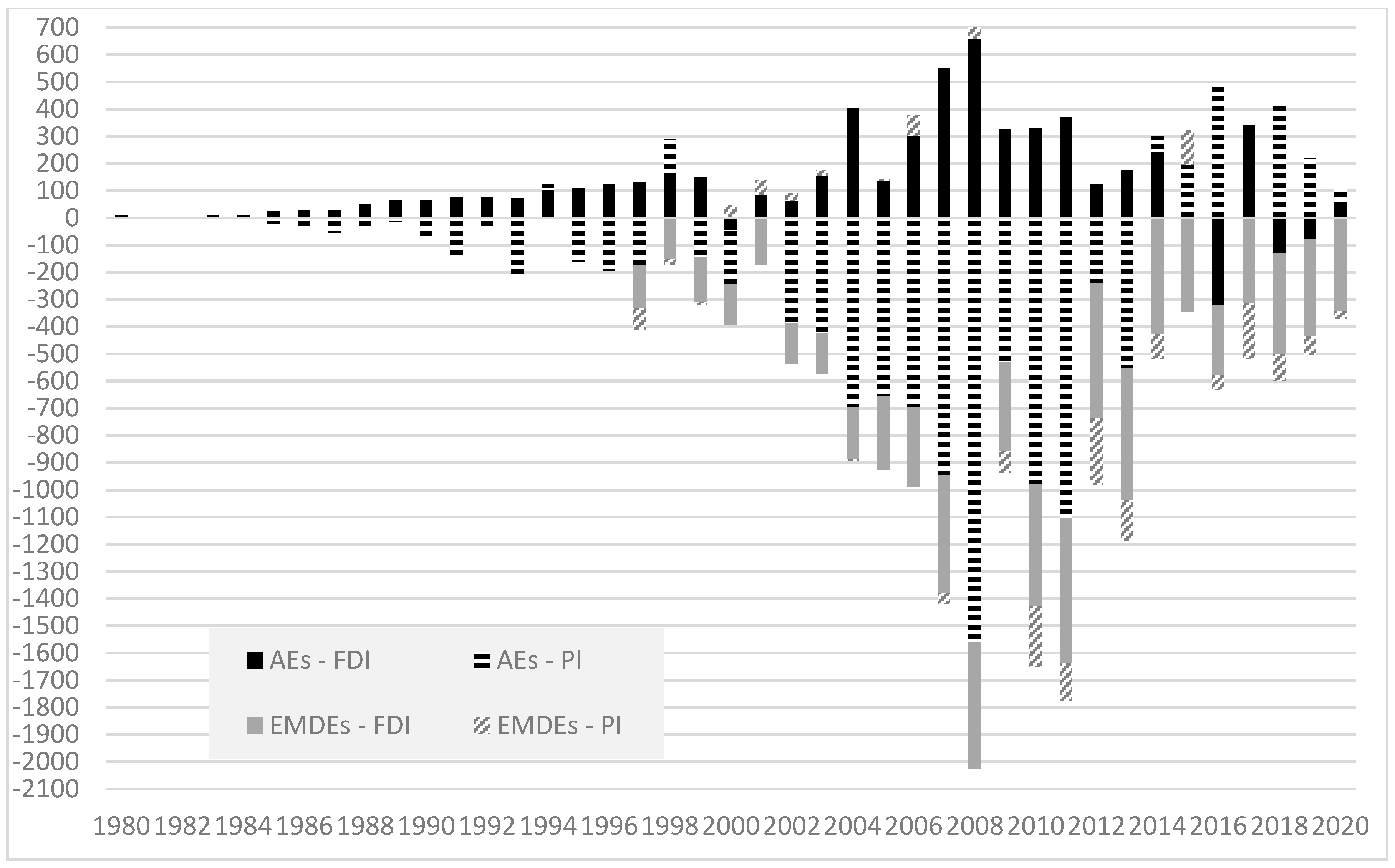
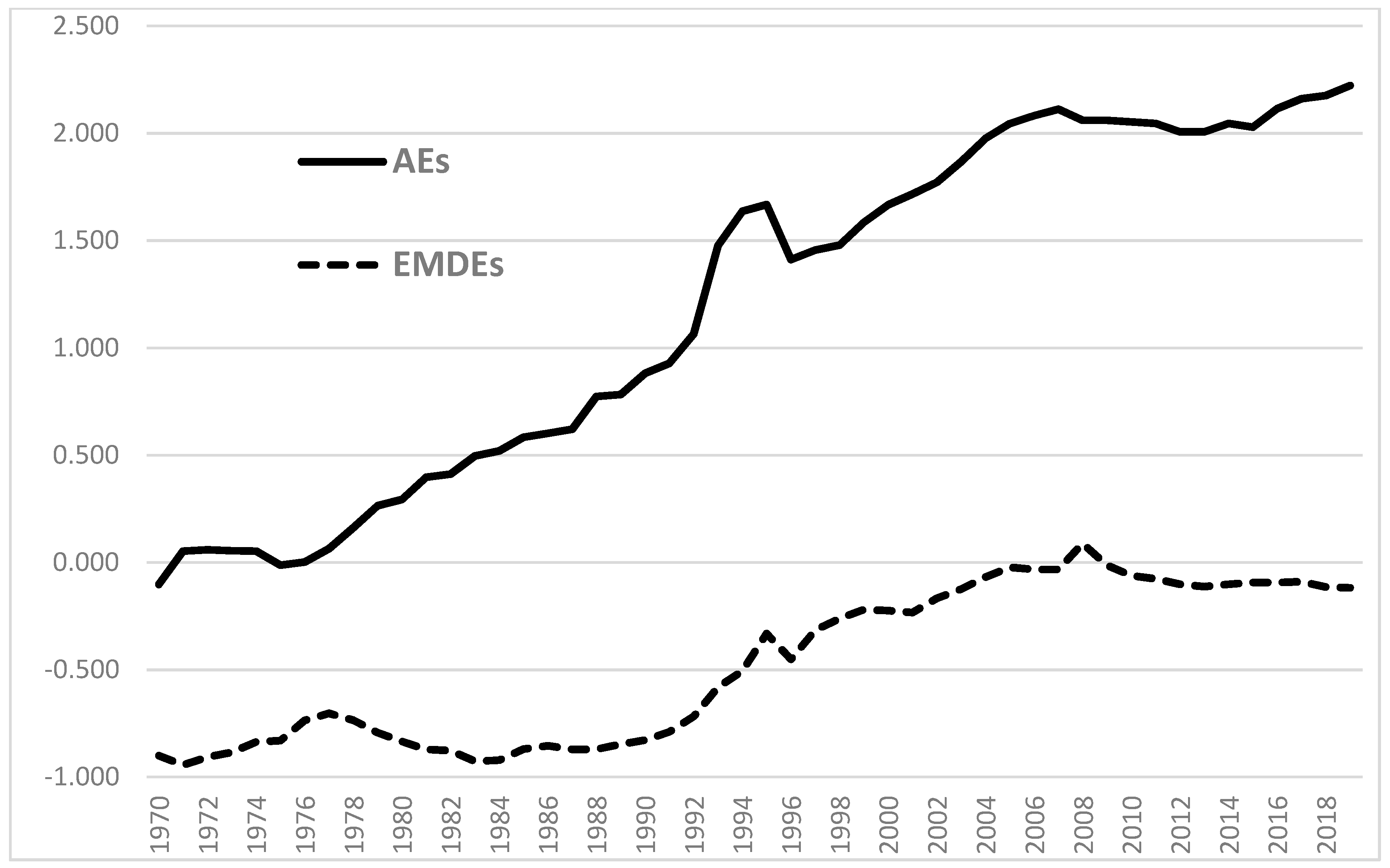
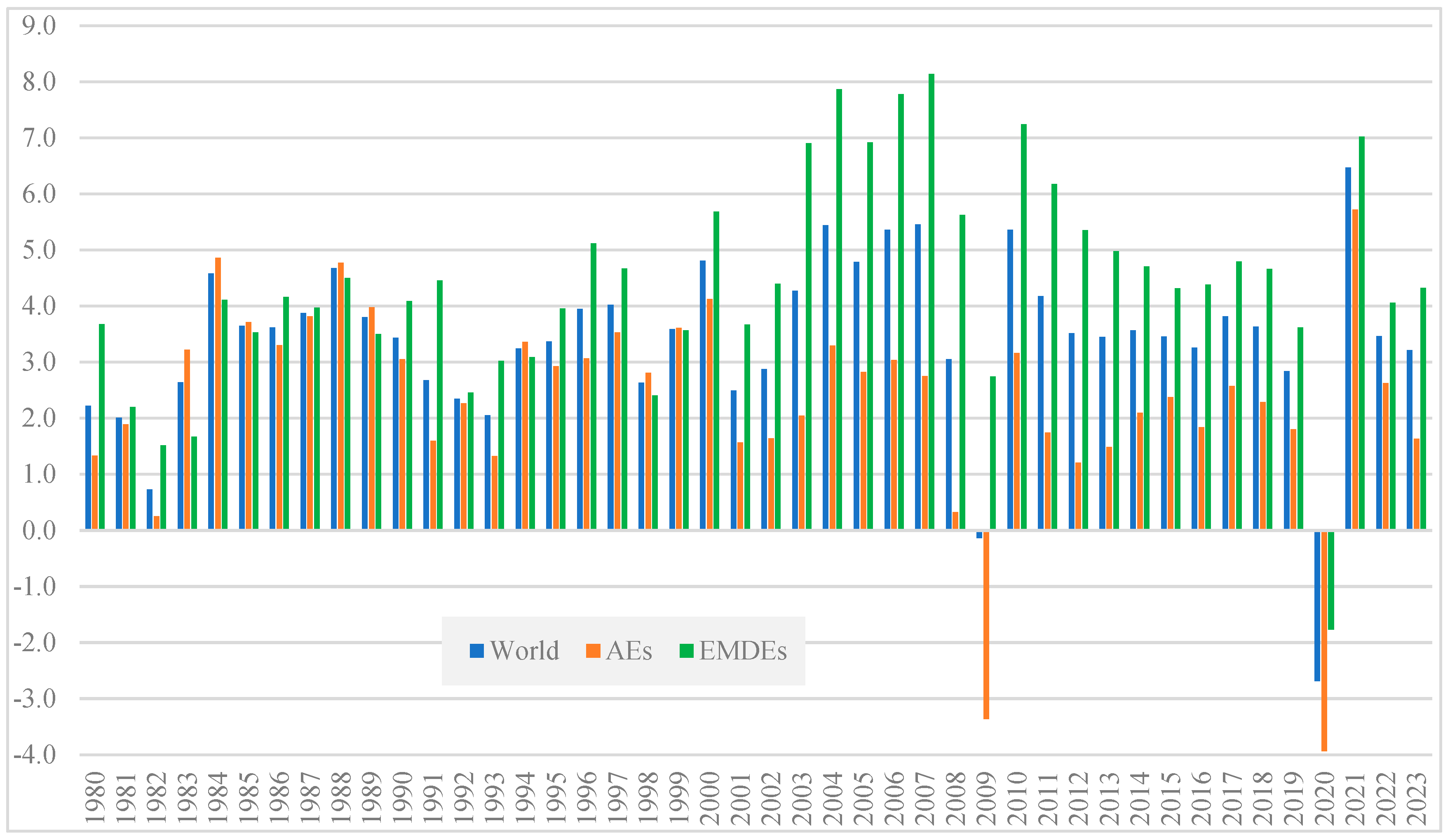

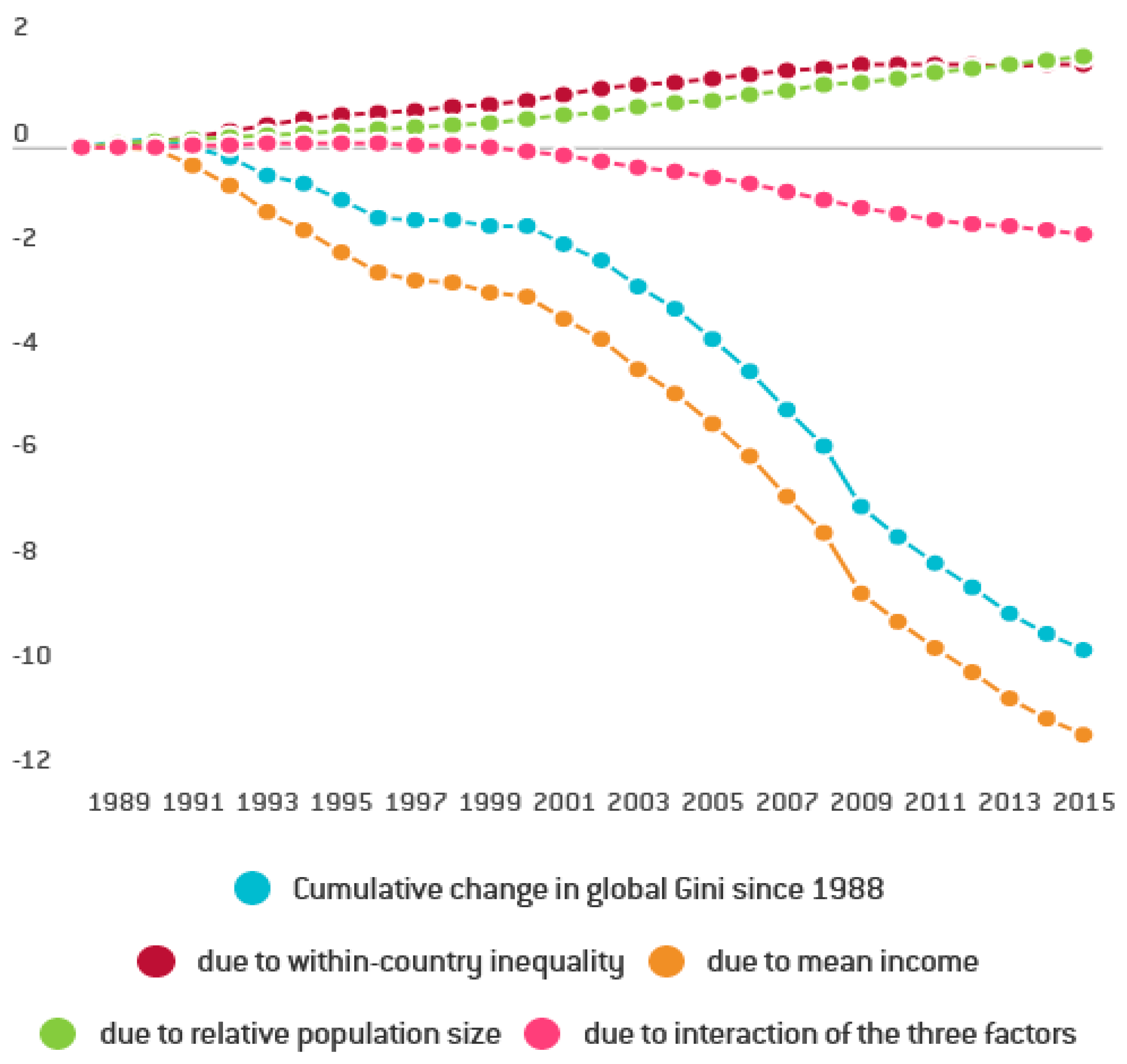

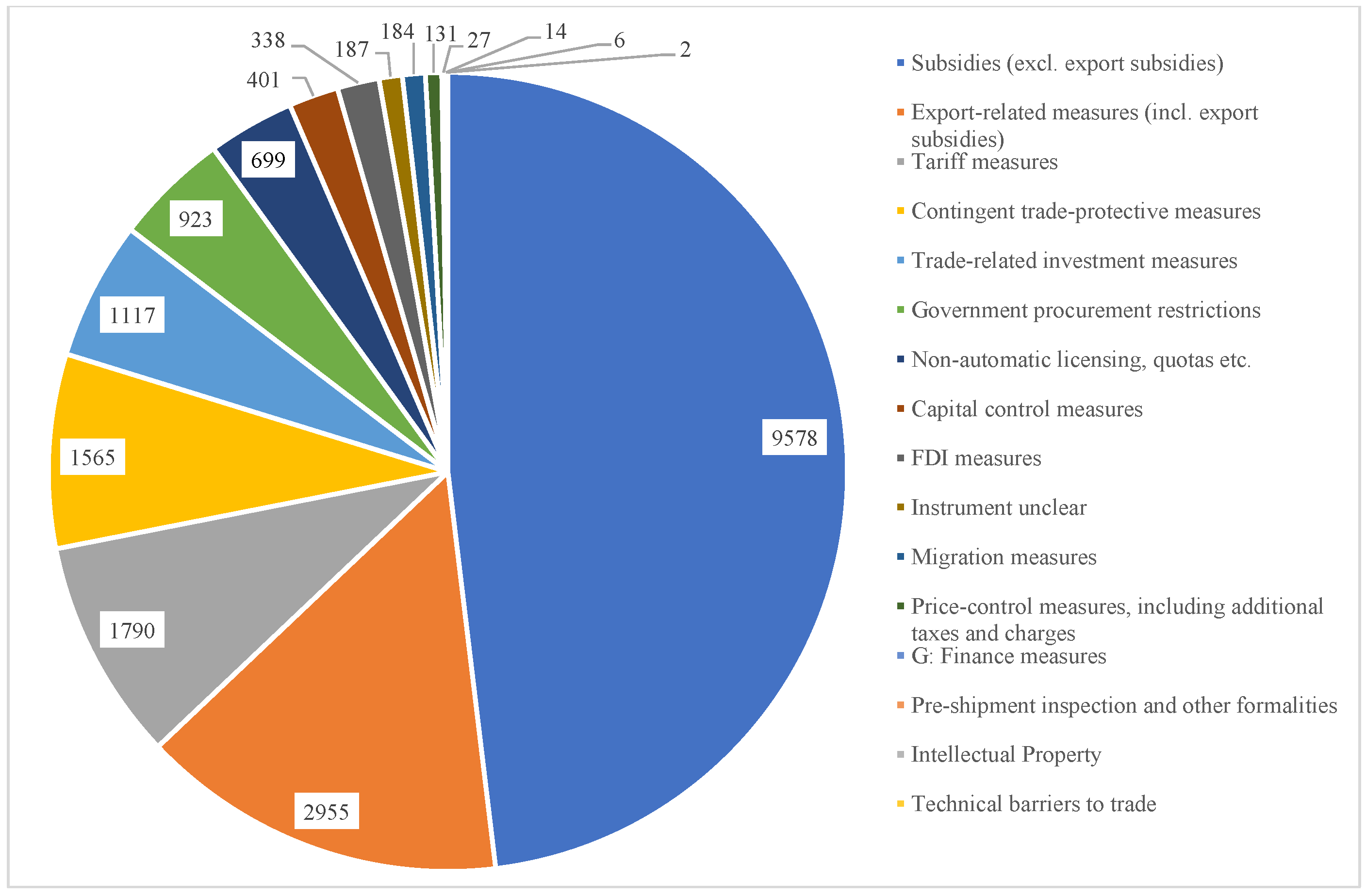
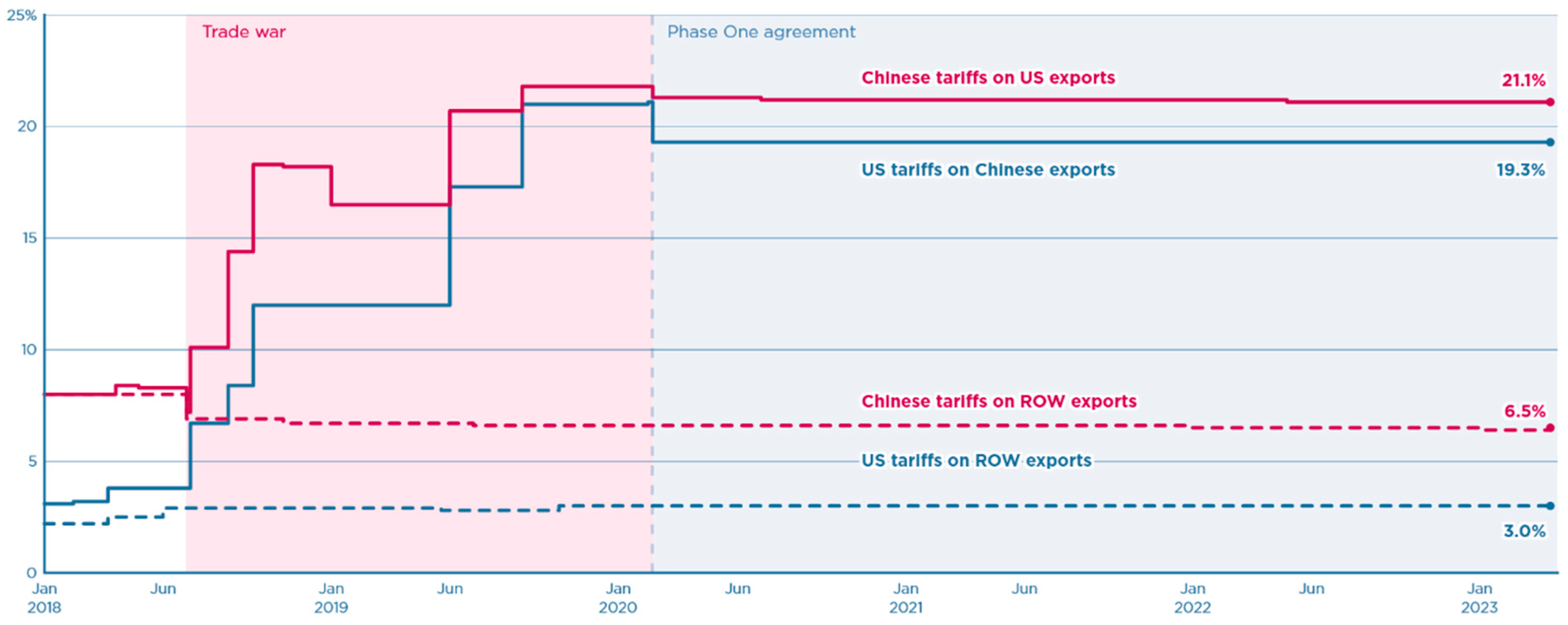
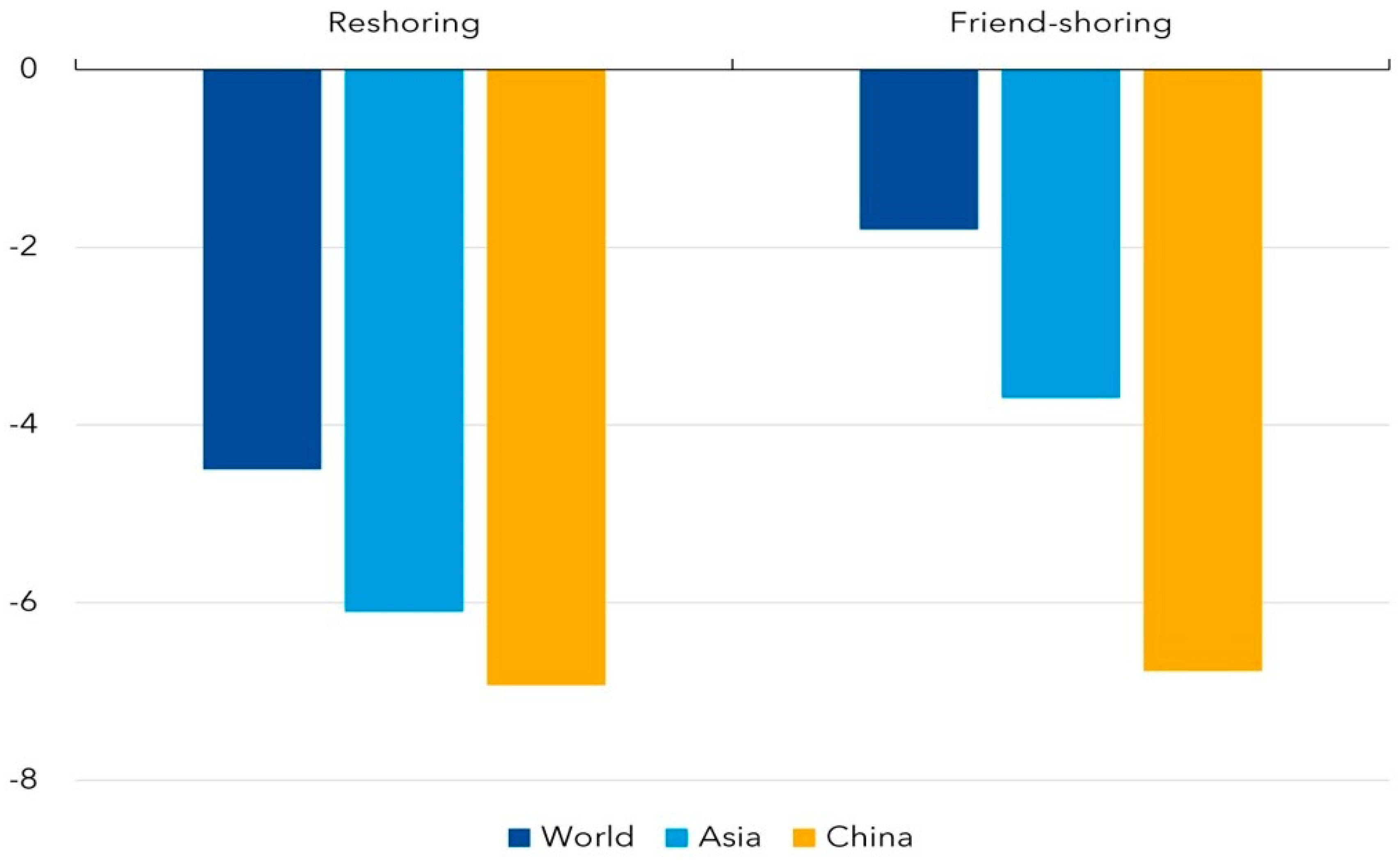
| Year | Place/Name | Subjects Covered | Countries |
|---|---|---|---|
| 1947 | Geneva | Tariffs | 23 |
| 1949 | Annecy | Tariffs | 13 |
| 1951 | Torquay | Tariffs | 38 |
| 1956 | Geneva | Tariffs | 26 |
| 1960–1961 | Geneva Dillon Round | Tariffs | 26 |
| 1964–1967 | Geneva Kennedy Round | Tariffs and anti-dumping measures | 62 |
| 1973–1979 | Geneva Tokyo Round | Tariffs, non-tariff measures, “framework” agreements | 102 |
| 1986–1994 | Geneva Uruguay Round | Tariffs, non-tariff measures, rules, services, intellectual property, dispute settlement, textiles, agriculture, creation of WTO, etc. | 123 |
| Region | 1981 | 1986 | 1991 | 1996 | 2001 | 2006 | 2011 | 2016 | 2019 |
|---|---|---|---|---|---|---|---|---|---|
| East Asia and Pacific | 83.5 | 68.3 | 63.9 | 45.5 | 37.2 | 21.0 | 10.4 | 2.3 | 1.2 |
| Europe and Central Asia | .. | .. | 3.7 | 8.3 | 8.3 | 5.5 | 3.8 | 2.8 | 2.3 |
| Latin America and the Caribbean | 15.1 | 12.4 | 16.1 | 16.2 | 13.2 | 8.5 | 6.0 | 4.4 | 4.3 |
| Middle East and North Africa | .. | 7.3 | 6.9 | 4.8 | 3.5 | 2.6 | 2.2 | 6.0 | .. |
| South Asia | 58.0 | 52.3 | 49.0 | 41.9 | .. | 33.5 | 21.4 | 15.8 | 8.6 |
| Sub-Saharan Africa | .. | .. | 55.7 | 57.6 | 55.5 | 47.4 | 41.0 | 37.2 | 34.9 |
Disclaimer/Publisher’s Note: The statements, opinions and data contained in all publications are solely those of the individual author(s) and contributor(s) and not of MDPI and/or the editor(s). MDPI and/or the editor(s) disclaim responsibility for any injury to people or property resulting from any ideas, methods, instructions or products referred to in the content. |
© 2024 by the author. Licensee MDPI, Basel, Switzerland. This article is an open access article distributed under the terms and conditions of the Creative Commons Attribution (CC BY) license (https://creativecommons.org/licenses/by/4.0/).
Share and Cite
Dabrowski, M. The Risk of Protectionism: What Can Be Lost? J. Risk Financial Manag. 2024, 17, 374. https://doi.org/10.3390/jrfm17080374
Dabrowski M. The Risk of Protectionism: What Can Be Lost? Journal of Risk and Financial Management. 2024; 17(8):374. https://doi.org/10.3390/jrfm17080374
Chicago/Turabian StyleDabrowski, Marek. 2024. "The Risk of Protectionism: What Can Be Lost?" Journal of Risk and Financial Management 17, no. 8: 374. https://doi.org/10.3390/jrfm17080374
APA StyleDabrowski, M. (2024). The Risk of Protectionism: What Can Be Lost? Journal of Risk and Financial Management, 17(8), 374. https://doi.org/10.3390/jrfm17080374






